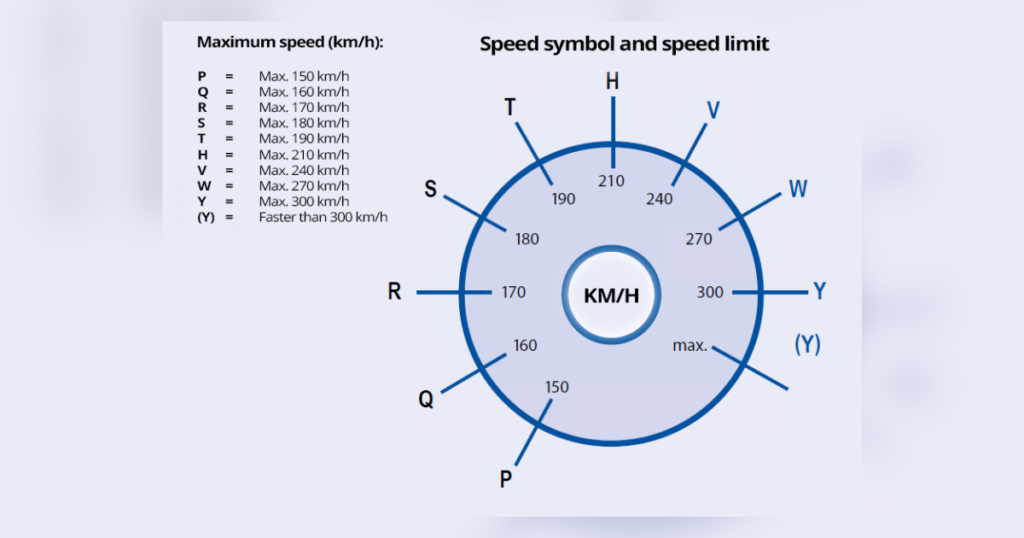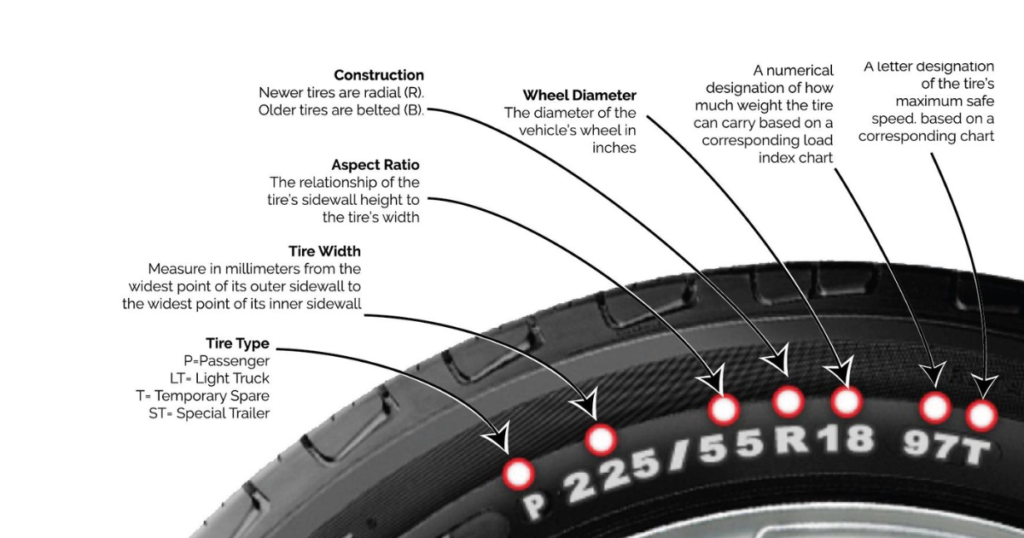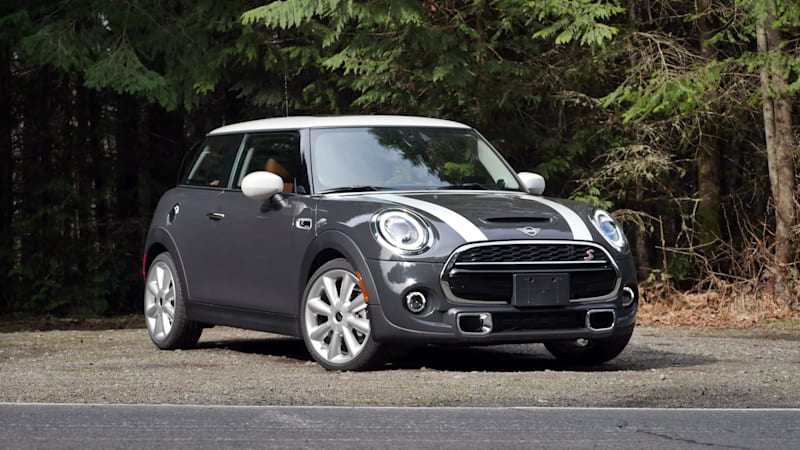
Even to the most amateur drivers, one truth is universal: all tires are not created equal. They differ in size, handling, season, suitable terrain, as well as the maximum safe speed at which they can operate. The speed rating determines this maximum operating speed, making it easier to compare different tires and pick the right ones.
Choosing tires with the correct ratings is crucial for driving safety and control. Tires are sized and shaped to meet the standards of manufacturers. While there is room for changes in some areas, it is not recommended for others. The speed rating, for instance, should not be changed too much. V and H speeds are the two common tire speed ratings for performance tires and sports cars. But which is better?
The main difference between H and V ratings is the tempo. An H tire’s maximum pace operating is about 130 mph under favorable circumstances. In contrast, a V-rated tire’s top speed is slightly faster than an H-rated tire, around 149 mph.
Symbols and Values Used in Speed Ratings
It is the highest-speed wheel that can operate before degradation appears. The greater the speed rating, the better the grip, but the shorter the tread life, the worse the cold-weather performance and the less comfortable the ride. On average, tires with greater speed ratings manage better at slower speeds. It especially determines their ability to bear the extra heat.

Each letter in the tire show speed symbols, starting at the lowest from A1 (3 mph) to the high ZR(Y) (above 186 mph). All the speed symbols, except “H,” follow the alphabet. Since it is the highway speed tire, the letter “H” is located between the letters “U” and “V.”
Only three letters, S, H, and V, were needed when the speed rating was initially introduced in the 1960s. As tire technology advanced, so did the alphabet table, which now contains nearly every letter. Under A, there are 8 sub-ratings with increasing increments. After that, they continue from B to Y. In the chart, I and Z are missing; H is also not in the correct spot.
Z is for the highest last 3 speed ratings designated as ZR. H is high because it was initially the top speed for which tires could be certified. It remained close to the upper end even when technology allowed tires to tolerate faster speeds because adjusting the ratings would have been inefficient. Additionally, some speed ratings, such as 149 mph for V, are slightly strange because they were originally designated in kph.
Ratings are easy to understand and interpret. The load index and the tire’s dimensions determine the tire’s maximum speed. Hence, a tire that has the sidewall marking 205/55R16 91V is a V-rated tire. Every tire has its own size codes that you can find on its sidewall.
Caution: The tire speed rating differs from the recommended travel speed. The rating will nearly always exceed maximum highway speed limits because the quoted speeds were calculated under ideal conditions. Do not test your tire’s limits by driving faster than the law allows.
| Speed Rating | Speed in km/h | Speed in mph |
| A1 | 5 | 3 |
| A2 | 10 | 6 |
| A3 | 15 | 9 |
| A4 | 20 | 12 |
| A5 | 25 | 16 |
| A6 | 30 | 19 |
| A8 | 40 | 25 |
| B | 50 | 31 |
| C | 60 | 37 |
| D | 65 | 40 |
| E | 70 | 43 |
| F | 80 | 50 |
| G | 90 | 56 |
| J | 100 | 62 |
| K | 110 | 68 |
| L | 120 | 75 |
| M | 130 | 81 |
| N | 140 | 87 |
| P | 150 | 94 |
| Q | 160 | 100 |
| R | 170 | 106 |
| S | 180 | 112 |
| T | 190 | 118 |
| U | 200 | 124 |
| H | 210 | 130 |
| V | 240 | 149 |
| W | 270 | 168 |
| Y | 300 | 186 |
Speed Rating History
When it comes to speed rating, we have the Germans to thank. In the 1980s, the Germans came up with the tire speed rating system, for it is essential to know what speed your tires can handle on autobahns with no speed limits, as they are the limiting factor.
Location of Speed Rating on the Tire

The sidewall of a tire typically includes the following information from left to right:
- Tire class (indicated by a letter).
- Section width (indicated by a number).
- Aspect ratio (indicated by a number).
- Tire construction (indicated by a letter).
- The load index (a two- or three-digit number corresponding to the weight each tire can support).
- Speed rating. The speed rating will be displayed on a label on the front driver’s door and in the vehicle’s owner’s handbook.

Using this code, we find the speed rating, usually the last item in the code’s character sequence. For example, in this tire code: “P507/80R16 82S,” S is the speed rating. The speed rating on each tire should match what the manufacturer recommends.
Why do Tires Have Different Speed Ratings?
Manufacturers produce numerous product models, such as tires. Therefore, little variations are to be anticipated. The strength and longevity of a tire begin with its inner workings and construction. More robust construction is required because the rotating forces at higher speeds are enough to rip the tire from the inside.
The presence of friction also contributes to generating heat; the higher the frictional resistance of a tire, the hotter it will get. Higher-rated tires have a rubber compound that is softer but better at absorbing heat, allowing them to last for longer on the road.
A high-speed rating does not guarantee the tire will remain intact even when traveling at high speeds. It also implies that it should be capable of providing exceptional performance. The rubber compound is essential for providing grip and traction at high speeds.
How Is the Speed Rating Determined?
Even before the tires are made, theorizing begins. The safest possible tire speed can be “guessed” by manufacturers based on data from prior testing and studies. Once production has begun, testing to back up the claims made at the beginning of the process can commence.
Ratings for maximum speeds result from testing in a controlled environment using simulated speeds and loads. A tire must prove it can maintain a certain speed before being given a speed rating. Reaching and maintaining a specific speed during a test is governed by industry regulations.
However, it is essential to recognize that the laboratory cannot simulate every possible condition. Your tires’ speed rating measures how fast they can go in ideal conditions (i.e., fully inflated, vehicle running properly, good weather conditions).
Since inflation, wear, vehicle condition (including alignment), driving circumstances, and the duration at which speed is maintained might reduce a tire’s actual speed capability, your tire’s rated speed may be lower than the actual speed capability of your tire. The rating does not cover tires that have been repaired, altered, under-inflated, overloaded, or used over their speed limits.
Comparing H and V Tires
Before diving deeper into which is better for your performance vehicles, we should acknowledge some points that differentiate them. It is not a one-and-only point that differentiates between H and V tires. However, changing speed limits could result in many alterations.
| Property | H-Rated Tire | V-Rated Tire |
| Tempo or Top velocity (mph) | 130 | 149 |
| Nature of ride | – Pleasant in typical driving situations. – Focus on the good passenger experience. | – Superior handling. – Handling-focused performance. |
| Sidewall | Less sturdy | Sturdy to accommodate faster speeds. |
| Type of car | – Sport – Sedan – Coupe – Crossovers – Crossover SUVs – The lowest end of the sports vehicle spectrum. | Sports Car |
| Rubber compositions and tread patterns | Sturdy to accommodate faster speeds. | – Designed for dry road grip and handling. – Can handle aggressive driving. |
| Comfort | If driving according to the normal limits, the H tire would be a better choice. | – Stiffer construction gives a comfortable driving experience and maximum speed on uneven road surfaces. – Consider the V tire if your driving style is taking a corner quickly or driving a sports car. |
| Tread Life Longevity | The better option | – Shorter – Expected to lose approximately 10,000 to 10,500 miles because of the rubber compound’s softness. |
| Consumer report testing on tread life | Consumer Reports tested that H-rated tires lasted an average of 49,180 miles. | 48,260 miles |
| Rubber Compound | Tough | Soft |
| Price | Reasonable | Expensive |
| Safety at high speeds | Less than V-rated | Safer |
Safety Considerations
Both are equally safe under most settings. The safety of your tires shouldn’t change depending on their speed rating, provided that you keep them properly inflated and in good condition. At really high speeds, one tire might be safer than the other. The “V” rated tire is safer than the “H” rated tire at higher speeds.
The figures for speeds are based on laboratory testing under ideal conditions. This means a tire’s safe speed may be less than its rated speed due to external circumstances. Tires, for instance, are subjected to laboratory testing at 100 degrees Fahrenheit. This is much cooler than it can get in Arizona on a typical summer day. Some considerations to keep in mind are as follows:
- The tire could have damage you do not know about, which could cause it to fall well below its rated speed.
- There could be missed damage in the form of a plug or patch, limiting tire integrity.
- The primary cause of tire rupture is underinflated tires. An overinflated tire can also be dangerous, but not as bad as underinflated tires.
FAQs
Do I need to know my tire’s speed rating?
Unaware drivers may get on the freeway, set the cruise control for the posted 70 or 75 mph, and then have a tire blowout a few miles down the road. Tire failure is never a pleasant experience.
They can cause several thousand dollars in damage and leave you stranded on the side of the road. Understanding your speed rating is crucial for avoiding difficult situations.
Can I formulate ratings of my tires on my own?
You shouldn’t determine this on your own because car manufacturers do that for you. This is a job for professionals and must never be attempted by amateurs.
What else can differ with speed ratings?
Tires with higher speed ratings may perform and feel more refined but also wear out quickly. Over 150 mph tires are made of a softer compound and wear out more quickly. For this reason, performance tires typically don’t come with a treadwear warranty, or the warranty is only a third as long as touring tires.
On the other hand, Grand touring tires with a more extended treadwear warranty won’t be the fastest option available.
Can I mix tires with different speed ratings?
You shouldn’t switch between different tire brands or tread patterns. Although manufacturers do not often endorse tire mixing, there are a few rare cases where it is allowed, such as with certified mixed tire installations.
For optimal safety and performance, front and rear tires should have the same make, model, size, tread pattern, load index, and speed rating. Mismatched tire size, construction, load index, or speed rating can endanger you and other drivers.
Can I Get Tires With a Higher Speed Rating?
Choosing tires with a higher speed rating is not generally a problem. Knowing that you won’t be reaching the upper-speed mark as quickly may, in some ways, even provide you peace of mind.
For example, if the top speed of your car is 120 mph, the manufacturer recommends H-rated tires for 130 mph, but you choose to go for V-rated ones for 149 mph. All this means is that you can go faster before reaching the limit set out by the manufacturer.
What Happens If You Go Over the Speed Rating of a Tire?
Simply exceeding the rating for a moment is unlikely to cause tire failure. Most tire blowouts happen when drivers consistently push their vehicles above their limits. Tread separation and blowouts become more frequent when your tires heat up. This can lead to a loss of control, which is dangerous for you and other motorists on the road.
Conclusion: So, what tire is best for you?
Picking the best between these speed ratings comes down to what you need from your tire. If you are looking for higher-speed performance, a V-speed-rated tire is what you need. But if you want a cheap, longer-lasting, more comfortable tire, you are better off getting H-rated tires.




